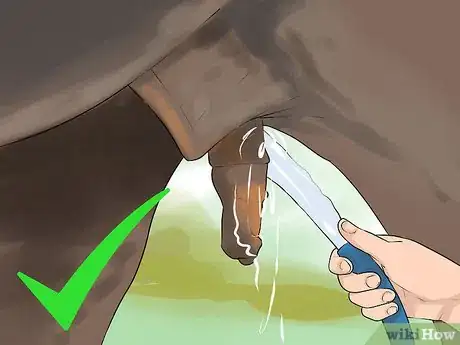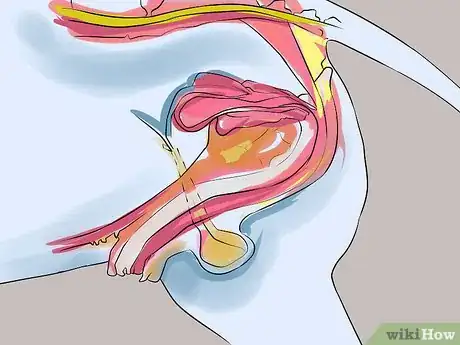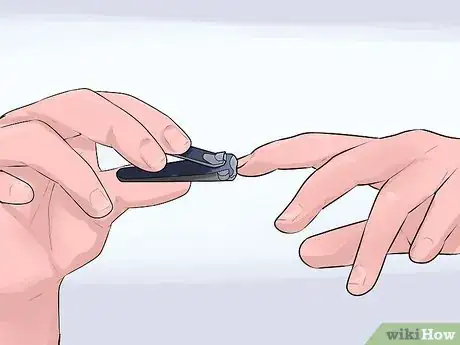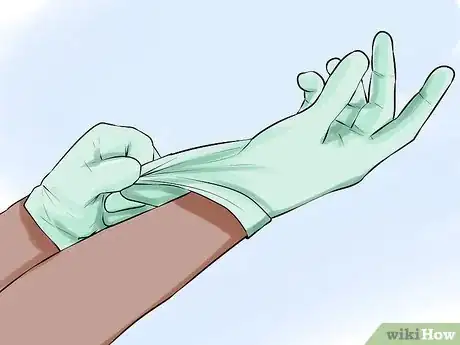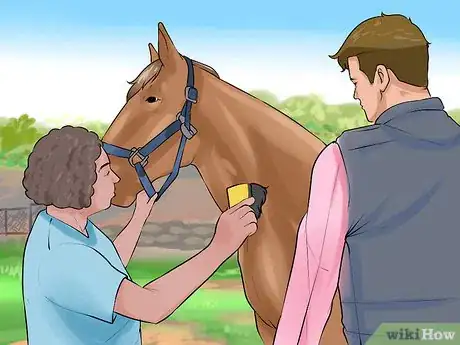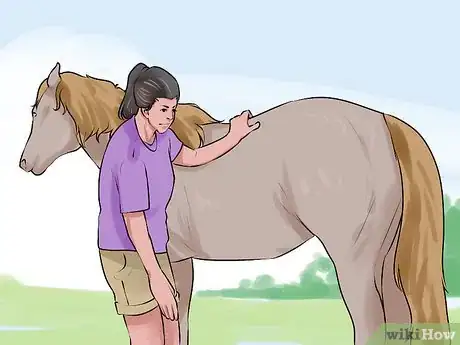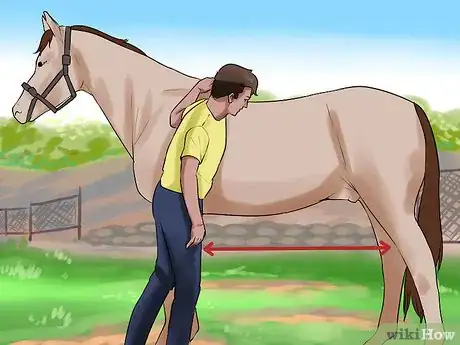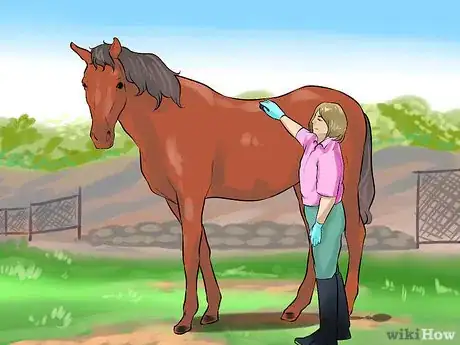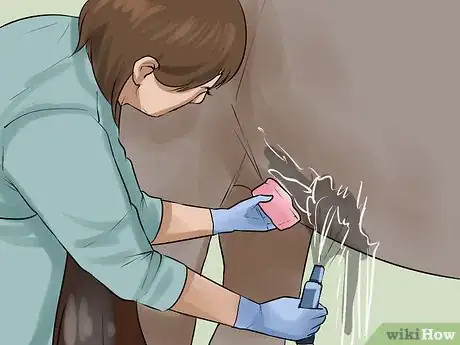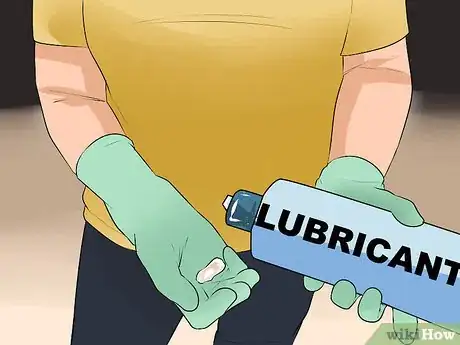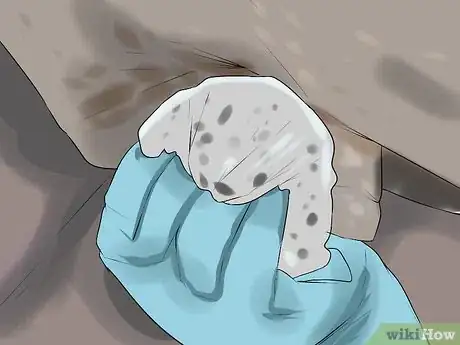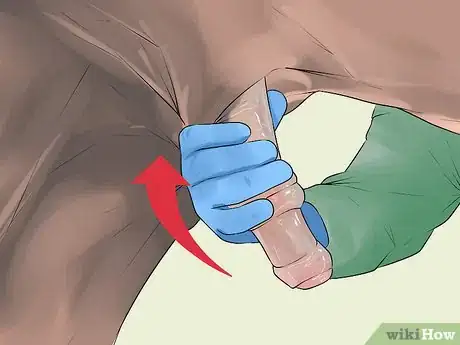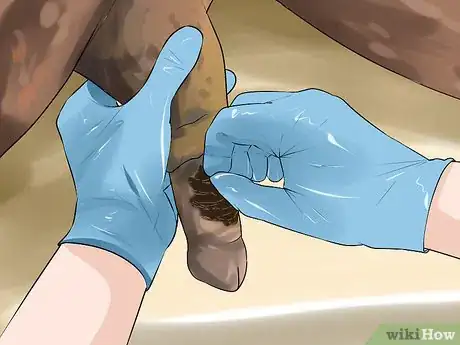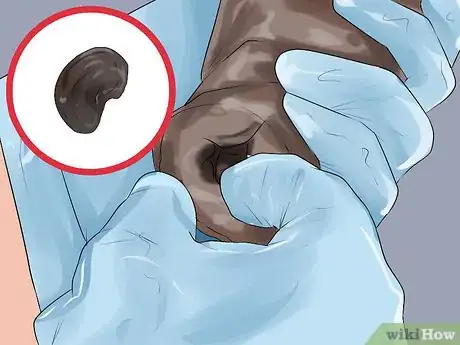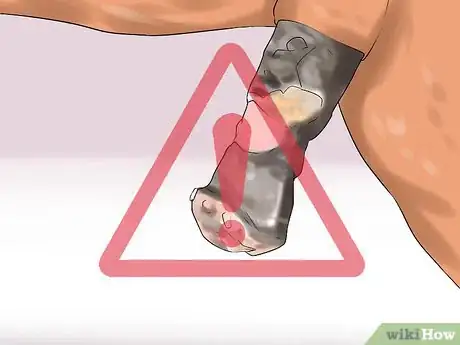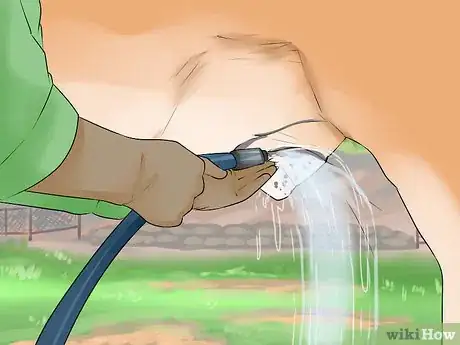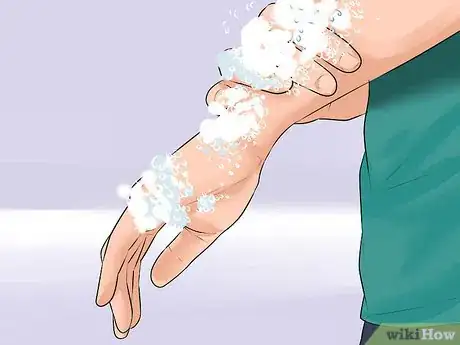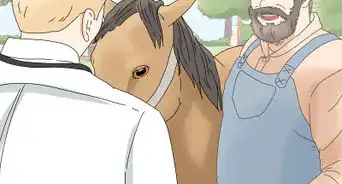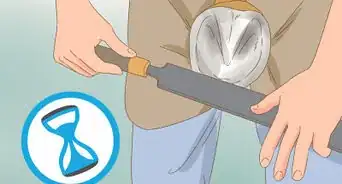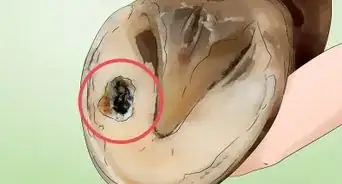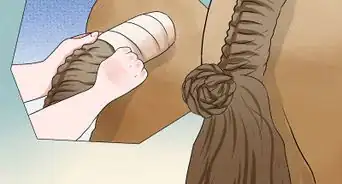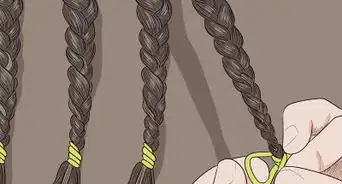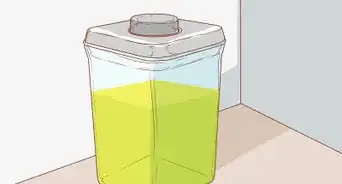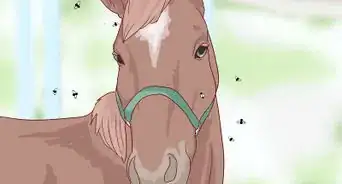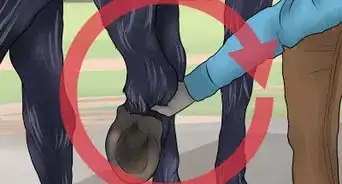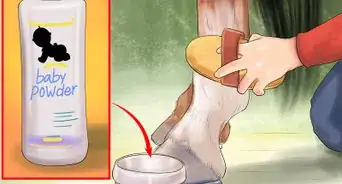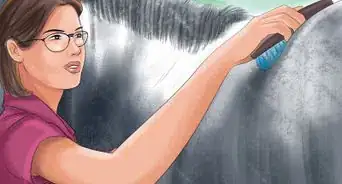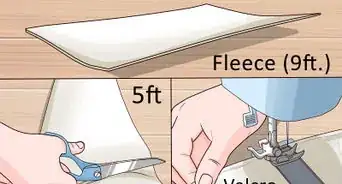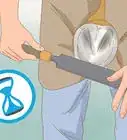This article was co-authored by Pippa Elliott, MRCVS. Dr. Elliott, BVMS, MRCVS is a veterinarian with over 30 years of experience in veterinary surgery and companion animal practice. She graduated from the University of Glasgow in 1987 with a degree in veterinary medicine and surgery. She has worked at the same animal clinic in her hometown for over 20 years.
wikiHow marks an article as reader-approved once it receives enough positive feedback. In this case, 85% of readers who voted found the article helpful, earning it our reader-approved status.
This article has been viewed 490,111 times.
The sheath is a tube of skin that protects the horse's penis. Smegma or a lubricating secretion fills the inside of the horse's sheath. In the wild, a horse would work out this lubrication naturally through sex, but in a domesticated setting, this secretion tends to build up, forming “beans” within the horse's sheath. Not every horse has this problem, nor is there a consensus on whether or not a sheath should be cleaned. Either as a preventative or reactionary measure, in consultation with your vet, you may decide to periodically clean your horse's sheath. Normally, this cleaning should be done at least every 6 months for a gelding (a castrated male horse) and every year for a stallion (an uncastrated male horse).[1] A male horse's genitalia is very sensitive, so you need to proceed carefully.
Steps
Deciding Whether or Not to Clean Your Horse's Sheath
-
1Understand the pros. In general, arguments in favor of washing a horse's sheath focus on hygiene and reducing the chances of infection. Bacteria tend to colonize around the smegma. The exact nature of the secretion and the likelihood of infection vary from horse to horse. No matter what, an excessive build-up can lead to irritation and inflammation in any horse. In turn, the sheath can swell up, which can restrict the horse's ability to procreate or even urinate. Some owners report that excessive smegma actually attracts flies, which carry disease.
-
2Understand the cons. Many experts argue that a horse's sheath “self-cleans”, so washing it by hand might actually be harmful. It could disrupt your horse's normal physiological system or you might end up damaging its sheath in the process. Others argue that it is not necessary to wash a gelding because they have been castrated, thus reducing the horse's natural production of smegma.[2]
-
3Consult your veterinarian. In the end, regardless of which side of the debate you support, you should discuss this issue with your vet. When it comes down to deciding whether or not to clean your horse's sheath, you'll need to consider your situation — your specific horse. Some horses are more susceptible to smegma or bean build-up. This can be the result of glandular or hormonal issues. Some beans will naturally shake loose and others won't. If left alone, these can be considerably dangerous and may even require surgery to remove.[3]
Getting Prepared
-
1Cut your nails. Cut them as short as possible and/or file down any sharp edges. Since a horse's sheath is incredibly sensitive, you'll want to eliminate the possibility of scratching the horse. Keep in mind that the horse's instinctual response to discomfort in its nether regions will be to kick and buck, which can lead to serious injury — for you and/or the horse.
-
2Put on thin latex gloves. Do not use thick rubber washing gloves. This might offend your sense of propriety, but it is more important that you retain your tactile senses. You'll need to be able to feel for any built-up smegma secretions or beans.[4]
-
3Ask someone to help restrain your horse. They can hold the reins, which will keep the horse facing a specific direction. They can also brush the horse to calm them while you do the dirty business. If you are alone, tie the horse safely and securely.
-
4Place your free hand gently on the horse's back. This helps you feel for your horse's movements so you can move out of the way quickly in case he moves to kick. Many horse owners and vets also claim that a trusting horse will be comforted by your hand too.[5]
-
5Stand towards the front of the horse. It is safest to stand with your hip and shoulder near the horse's front legs. Since horses kick with their back legs, you want to stay as far away from them as possible.[6]
-
6Perform the cleaning in an open area. Since you need a hose and want to avoid being trampled, you'll want to clean your horse's sheath in an open area - perhaps in your barn. Don't stuff yourself and your horse in a small stable stall. You won't have anywhere to turn.[7]
Cleaning the Sheath
-
1Use a soft sponge and hose to gently wet the sheath and penis. Start from the belly and work towards its penis so that the horse isn't surprised. Use room temperature water, if possible. Hot water and cold water can be uncomfortable for your horse. Your goal here is to sluice off dirt and other contaminants from the outside of the sheath. Discard the used sponge after completion.[8]
-
2Use lubricant. Lubricate your hand and the sheath with either KY Jelly or a commercial sheath cleaner. In order to remove the smegma or “beans,” you'll need to lubricate the region. This will also make the process less stressful/painful for the horse.[9]
-
3Wipe away grime from the sheath. Take a soft sponge or a pad of cotton wool and wipe gently along the outer edge of the horse's sheath. Remove all smegma, dirt, and any other foreign materials that may have built up. Use room temperature water to rinse, while wiping. Do not wipe too aggressively. Work the sponge or pad of cotton wool in small circles as you move along the sheath. [10]
-
4Gently push back the sheath with one hand. Push it as far as your can before inserting your hand. At most, your horse's sheath will slide 1 or 2 inches (2.5 or 5.1 cm) back. This will reduce the pocket that forms around the penis and will making cleaning easier. Not all horses will allow you do to it. If you do this frequently enough, your horse will become used to the sensation and won't resist.[11]
-
5Remove smegma from around the penis with your other hand. It will probably be a rusty color. This is normal. The smegma (dried excretions) will usually flake and peel away in your hand. Bring out as much as possible and use a lot of lukewarm water to rinse.[12]
-
6Check for beans (lumps of smegma) in the urethra. Insert your little finger into the urethra and feel for a hard lump. If it is there, slowly roll it out of the tip of the horse's penis. Some call this harvesting beans. You will feel it before you get to your first knuckle. Beans rarely form deeper than this and if they do, they require surgery to remove.[13]
-
7Check for abnormalities. Check for thick skin, grayish skin color in normally pink areas, and lesions. If you see any of these, you should consult your veterinarian. These can be the result of improper genital care, but may also be symptomatic of other dietary, bacterial, and viral issues.[14]
-
8Use a sponge or hose to gently rinse the sheath and penis. If you used soap, make sure it is all washed off. Left-over soap residue can cause problems of its own like skin irritation.[15]
-
9Clean up. You've just completed a gross job. Use a strong anti-bacterial soap and wash your hands and forearms several times.[16]
Expert Q&A
Did you know you can get expert answers for this article?
Unlock expert answers by supporting wikiHow
-
QuestionWhat are the symptoms of twisted gut in a horse?
 Pippa Elliott, MRCVSDr. Elliott, BVMS, MRCVS is a veterinarian with over 30 years of experience in veterinary surgery and companion animal practice. She graduated from the University of Glasgow in 1987 with a degree in veterinary medicine and surgery. She has worked at the same animal clinic in her hometown for over 20 years.
Pippa Elliott, MRCVSDr. Elliott, BVMS, MRCVS is a veterinarian with over 30 years of experience in veterinary surgery and companion animal practice. She graduated from the University of Glasgow in 1987 with a degree in veterinary medicine and surgery. She has worked at the same animal clinic in her hometown for over 20 years.
Veterinarian Twisted gut or colic is very painful. The horse will be restless and seem distressed, with flared nostrils and dilated eyes. They may look, or even kick, at their flanks. Some horses strain as if trying to pass droppings, but nothing comes out. They sweat heavily, grunt, and their respiratory rate increases. The horse may also throw itself to the ground and try to roll. If you spot any of these signs, then contact a vet urgently.
Twisted gut or colic is very painful. The horse will be restless and seem distressed, with flared nostrils and dilated eyes. They may look, or even kick, at their flanks. Some horses strain as if trying to pass droppings, but nothing comes out. They sweat heavily, grunt, and their respiratory rate increases. The horse may also throw itself to the ground and try to roll. If you spot any of these signs, then contact a vet urgently.
Things You'll Need
- A male horse
- Latex gloves
- A bucket and soft sponge or a hose
- Warm water, about body temperature.
- Sheath cleaning soap (if necessary). Some ideas are Excalibur (a gel that can be quite cold, so warm it up in your hands prior to application), mild dye- and fragrance-free shampoo, or Ivory soap.
References
- ↑ http://www.thehorse.com/videos/30323/sheath-cleaning-for-male-horses-how-to
- ↑ http://www.aaep.org/info/horse-health?publication=819
- ↑ http://www.aaep.org/info/horse-health?publication=819
- ↑ http://www.equusite.com/articles/health/healthSheathCleaning.shtml
- ↑ http://www.equusite.com/articles/health/healthSheathCleaning.shtml
- ↑ http://www.equusite.com/articles/health/healthSheathCleaning.shtml
- ↑ http://www.equusite.com/articles/health/healthSheathCleaning.shtml
- ↑ http://www.thehorse.com/videos/30323/sheath-cleaning-for-male-horses-how-to
- ↑ http://www.equusite.com/articles/health/healthSheathCleaning.shtml
- ↑ http://www.thehorse.com/videos/30323/sheath-cleaning-for-male-horses-how-to
- ↑ http://www.thehorse.com/videos/30323/sheath-cleaning-for-male-horses-how-to
- ↑ http://www.thehorse.com/videos/30323/sheath-cleaning-for-male-horses-how-to
- ↑ http://www.thehorse.com/videos/30323/sheath-cleaning-for-male-horses-how-to
- ↑ http://www.thehorse.com/videos/30323/sheath-cleaning-for-male-horses-how-to
- ↑ http://www.equusite.com/articles/health/healthSheathCleaning.shtml
- ↑ http://www.equusite.com/articles/health/healthSheathCleaning.shtml
About This Article
To clean your horse's sheath, start by putting on latex gloves and ensuring someone is either holding the horse's reigns or it is tied in place. Next, put your free hand on the horse's back so you have a good sense of its movements. To reduce the chance of being kicked by your horse, stand close to its front legs. Start cleaning with a soft sponge and hose on its belly before moving towards its penis so the horse isn't surprised. Finally, lubricate the sheath with jelly, wash it with a sponge to remove grime, and push back the sheath before cleaning smegma from the penis. To learn how to check for "beans" in the urethra and how to identify abnormalities, read on!
